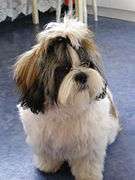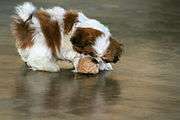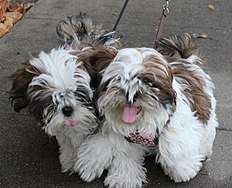Shih Tzu
The Shih Tzu (UK: /ˌʃiːˈtsuː/, US: /ˈʃiːˌtsuː/;[1] Chinese: 西施犬; pinyin: Xī Shī quǎn literally "Xi Shi dog", also spelled Shittsu) is a toy dog breed, weighing from 4 to 7.25 kilograms (9–18lb) when fully grown.[2] The breed was developed in Tibet.
| Shih Tzu | |||||||||||||||||||||||||||||||||
|---|---|---|---|---|---|---|---|---|---|---|---|---|---|---|---|---|---|---|---|---|---|---|---|---|---|---|---|---|---|---|---|---|---|
.jpg) A Shih Tzu in full show coat | |||||||||||||||||||||||||||||||||
| Other names | Ian Chrysanthemum Dog | ||||||||||||||||||||||||||||||||
| Origin | China | ||||||||||||||||||||||||||||||||
| |||||||||||||||||||||||||||||||||
| |||||||||||||||||||||||||||||||||
| Dog (domestic dog) | |||||||||||||||||||||||||||||||||
| Shih Tzu | |||||||||||||||||||||||||
|---|---|---|---|---|---|---|---|---|---|---|---|---|---|---|---|---|---|---|---|---|---|---|---|---|---|
| Chinese name | |||||||||||||||||||||||||
| Chinese | 西施犬 | ||||||||||||||||||||||||
| Literal meaning | Xi Shi dog | ||||||||||||||||||||||||
| |||||||||||||||||||||||||
| Alternative name | |||||||||||||||||||||||||
| Traditional Chinese | 獅子 | ||||||||||||||||||||||||
| Simplified Chinese | 狮子 | ||||||||||||||||||||||||
| Literal meaning | lion | ||||||||||||||||||||||||
| |||||||||||||||||||||||||
Description

The Shih Tzu is a sturdy little dog with a short muzzle and large dark brown eyes. They have a soft and long double coat. Although sometimes long, a Shih Tzu will not always have extremely lengthy hair like the Pekingese (but with short legs). Some of them have more short, curly hair. This is purely a choice made by the owners. A Shih Tzu should stand no more than 26.7 cm at the withers and with an ideal weight of 4.5 to 7.3 kg. Floppy ears are covered with long fur, and the heavily furred tail is carried curled over the back. The coat may be of any color, though white and with blazes of grey are frequently seen. A very noticeable feature is the underbite, which is required in the breed standard.[3]
The traditional long silky coat, which tends to reach the floor, requires daily brushing to avoid tangles. Because of their long coat and fast-growing hair, regular grooming is necessary and important, which may be expensive and should be taken into account when considering adopting one of this breed. Often, the coat is clipped short to simplify care, but the coat still requires daily brushing. For conformation showing, the coat must be left in its natural state, though trimming for neatness around the feet and anus is allowed. The shorter cut is typically called a "puppy cut"[4] or a "teddy bear cut" when the puppy cut is accompanied by a fuller, rounder face, resembling a cute and cuddley stuffed animal.
Temperament
Although an individual Shih Tzu's temperament varies from dog to dog, the breed has a personality and temperament that is loyal, affectionate, outgoing, and alert. They tend to be possessive around other dogs. Training and proper socializing must start at a young age for the Shih Tzu to obey basic commands, for the Shih Tzu is prone to stubbornness when it comes to training. While the Shih Tzu is an excellent watchdog because of its alert and active nature, it was not specifically bred for this purpose. Unlike the Lhasa Apso, which was bred to be a sentinel dog that enjoys high perches and is wary of strangers, the Shih Tzu prefers to be close to its companions and will often offer strangers its affection. Because of its friendly nature, the Shih Tzu tends to interact well with other dogs and with children and adults. They do well with singles, couples, and families with older children.[5] They may be a little temperamental with hyper or larger breeds, but generally, the Shih Tzu gets along well with other pets. They are generally well behaved and suitable for families.[6]
Coat colors and quality
The Shih Tzu comes in a range of colours that include various shades of gold, white, brown, and black. Other colours include black mask gold, black and white, solid black, solid liver, liver and white, brindle, white, red and white, and grey and white.[7] Thus, when two Shih Tzu mate, there is a possibility that their offspring's coat will be similar to the sire's color, dam's color, tricolor, or a mix of both parents' color in one classification. An interesting point (and often a point of confusion) is that while the coat color of those with black pigmented skin (nose, lips, pads, also referred to as "leather") is determined by the color of the coat itself; the coat color on dogs with either liver or blue pigment is categorized by the color of the pigment. Thus, a parti colored (white and another shade) Shih Tzu with blue pigment is a "blue and white" regardless of the tint of the hair which might very well appear similar to a gold and white or other colors. The same principle applies to solid blue, silver, and silver and white. Sometimes you might see dark brown pigments near the shoulders and between the armpits. The coat color changes as the dog gets older.
The typical fine, straight, and silky Shih Tzu coat has also been listed by many popular dog information websites as being hypoallergenic. In comparison with many other breeds, Shih Tzu do not shed to the same degree, only losing small amounts when bathed or brushed. It is the dog's dander and saliva that trigger most allergic reactions. Allergists do recognize that, at times, a particular allergy patient will be able to tolerate a particular dog; but they agree that "the luck of the few with their pets cannot be stretched to fit all allergic people and entire breeds of dogs". The Shih Tzu coat is said to fall out only when brushed or broken, or just said to shed.[8] The coat may also be wavy or coarse.[9]
Etymology
The name comes from the Chinese language word for "lion" because this kind of dog was bred to resemble "the lion, as depicted in traditional oriental art".[10] (The Pekingese breed is also called "lion dog" in Chinese.) "Shih Tzu" is the Wade-Giles romanization of the Chinese characters 獅子, meaning lion; this romanization scheme was in use when the breed was first introduced in America. In contemporary China, Pinyin is the predominant system of romanization, which renders it as shīzi. The Mandarin Chinese pronunciation is approximately SHIRR-dzə. Though the Wade-Giles system is often regarded as less intuitive, "Shih Tzu" is a useful linguistic example of both of two cases where the Wade-Giles scheme reflects the use of a syllabic fricative after a corresponding consonant cluster (retroflexes and sibilants) in modern Mandarin. This is a unique phonological feature that does not appear in any other known modern language in their standardized form. Indeed, though the exact classification is still debated (and dialectal variants exist), linguists generally agree that these sounds cannot be represented by conventional symbols in the IPA; hence an unorthodox approximation "SHIRR" was used earlier in this paragraph. However, the use of a syllabic fricative is often observed in informal English with the paralinguistic expression "Shh!", which may serve as a guide to the pronunciation of "Shih".

In the modern Chinese language, the Shih Tzu is generally known as the "Xi Shi dog"; Xi Shi was regarded as one of the most beautiful women of ancient China. The alternative name was adopted to avoid the confusion that stems from referring to the breed as a lion.[11] Shih Tzu were nicknamed the Chrysanthemum Dog in England in the 1930s.[12] The dog may also be called the Tibetan Lion Dog, but whether the breed should be referred to as "Tibetan" or "Chinese" is a source of both historical and political contention, as the subsequent section notes. A book on the breed states that "dog historians tend to have very strong opinions" on the subject.[13]
History
One theory is that the Shih Tzu descended from a cross between the Pekingese and Lhasa Apso,[14] a Tibetan dog given by the Dalai Lama to Chinese emperors near the end of the 17th century.[15] The dogs were favorites of the Chinese royals and so prized that, for years, the Chinese refused to sell, trade, or give any away. The first dogs of the breed were imported into Europe (England and Norway) in 1930 and were classified by the Kennel Club as "Apsos".[14] The first European standard for the breed was written in England in 1935 by the Shih Tzu Club,[16] and the dogs were categorised again as Shih Tzu. The breed spread throughout Europe and was brought to the United States after World War II, when returning members of the U.S. military brought back dogs from Europe and Asia, in the mid-1950s. The Shih Tzu was recognized by the American Kennel Club in 1969 in the Toy Group.[14]
In 1934, the Shih Tzu Club of England was founded[17] and the breed was officially recognised by the Kennel Club (UK) on 7 May 1940.[18] When it became eligible for Challenge Certificates, none were awarded until 1949. The breed is now recognized by all of the major kennel clubs in the English-speaking world.[3] It is also recognized by the Fédération Cynologique Internationale for international competition in Companion and Toy Dog Group, Section 5, Tibetan breeds.[3] In the United States, the Shih Tzu ranked the 15th most popular breed in 2013, falling slightly in popularity since 2012 when it was placed in 11th position.[19]
Health
A number of health issues, some of them hereditary, have been found in individual Shih Tzu, and are listed below.
Hypothyroidism
Hypothyroidism occurs when the thyroid gland malfunctions and stops producing a hormone responsible for proper metabolism. This malfunction is commonly attributed to immune system problems. It usually affects middle-aged dogs and is seen in all breeds. Symptoms include hair loss, weight gain, muscle loss, and lethargy. This disease is usually diagnosed through blood tests. It can be effectively treated with drug therapy.
Intervertebral disk disease
Intervertebral disk disease in the dog is a common chondrodystrophic disorder manifested by acute back pain, loss of coordination, paresis, and loss of the ability to feel deep pain sensations. IVDD commonly occurs in certain toy breeds, such as Dachshund, Pekingese, French Bulldog, Beagle, Basset Hound, American Cocker spaniel, Shih Tzu, Lhasa Apso, and Welsh Corgi.
Breathing problems
Shih Tzu have a number of respiratory problems related to the shape of their face and head. Brachycephalic airway obstructive syndrome is a common problem and mostly affects dogs with short noses (brachycephalic breeds). An obstruction in the upper airways causes the dog to have labored breathing. Not every brachycephalic dog will develop respiratory problems, but most will to some degree. Severe problems may require surgery.
Eye issues
It is very common for Shih Tzus to develop eye problems at any age, and even more so once they are older. Most veterinarians will recommend eye drops to assist with any eye irritations. Some dogs have allergies which causes excess discharge around the eye. Older Shih Tzu are known to develop cataracts which can be corrected with surgery. If not treated, the dog may become blind in the eye that has the cataract. The distinctive large eyes can easily be scratched which may cause an ulcer. The dog will normally have the injured eye closed or half closed and may have excessive tears.[20] The most common problem of Shih Tzus concerning eye conditions is the formation of epiphora caused by the fur on the eyelids scratching the conjunctiva and the cornea. However this can be mediated by the application of prescribed eye drops from a certified veterinarian.[21]
Other health issues
Some health issues in the breed are portosystemic shunt of the liver and hip dysplasia in standard sizes. There have been cases of Shih Tzu being epileptic, which in turn may lead to shortening of the lifespan of the Shih Tzu if untreated. Many Shih Tzu dogs are also prone to ear infections.[22]
The Shih Tzu may be more prone than other breeds to get a blood disease called immune-mediated hemolytic anemia, which causes their immune system to attack itself and kill off their blood cells. This can be found through blood tests but among the signs are yellowing of the skin/gums, tiredness, loss of appetite, and loss of balance that occurs over two days.[23]

Variations
Kennel club differences
There is a difference between the Shih Tzu of the American Kennel Club and the Kennel Club (UK):
The AKC (American Kennel Club) Shih-Tzu
- Their front legs (forequarters) are straight. Their hindquarters are muscular. Neither should be too short nor too long.
- The standard head is big and round and is set high with face looking forward or up.
- The neck and body are the most important and should not be exaggerated.[27]
- The eyes are large and face the front.
- The shoulders of the American type of Shih-Tzu are frontal.[28]
In popular culture
The Shih Tzu has been prominently featured in various films, including the mockumentary comedy film Best in Show (2000) – with a Shih Tzu named Miss Agnes;[29] , the dark comedy crime film Seven Psychopaths (2012) – starring a Shih Tzu named Bonny and in the animated comedy film The Secret Life of Pets 2 starring a Shih Tzu named Daisy.
The Shih Tzu has also been featured in video games. Isabelle, the mascot of the Animal Crossing series first appearing in Animal Crossing: New Leaf (2012), is a Shih Tzu. She is a playable character in Super Smash Bros. Ultimate.
See also
- Utility Group
References
- Upton, Clive; Kretzschmar, Jr., William A. (2017). The Routledge Dictionary of Pronunciation for Current English (2nd ed.). Routledge. p. 1231. ISBN 978-1-138-12566-7.
- "Shih Tzu Age | Weight Chart | Growth Chart | Shih Tzu Information Center". www.allshihtzu.com. Retrieved 2018-06-05.
- "Federation Cynologique Internationale Breed Standard" (PDF). Fci.be. Retrieved 11 December 2017.
- "United Kennel Club: Shih Tzu". United Kennel Club. 2007-05-01. Archived from the original on 2011-06-04. Retrieved 2011-05-30.
- "The Shih Tzu Personality/Temperament". Miracleshihtzu.com. Retrieved 30 August 2019.
- "Shih Tzus - Temperament & Personality". Petwave.com. Retrieved 11 December 2017.
- "Shih Tzu Colors | American Shih Tzu Club". americanshihtzuclub.org. Archived from the original on 2011-08-10. Retrieved 2010-05-16.
- "Top 10 Dog Breeds that Don't Shed". Dog-obedience-training-review.com. Retrieved 11 December 2017.
- "Shih Tzu". Purebredpups.org. Retrieved 11 December 2017.
- Shih Tzu, by Jaime J. Sucher, p. 5, Barron's Educational Series, 2000, ISBN 0-7641-1043-8
- Steve Allison. "Shih Tzu". FindOutAboutDogBreeds.com. Archived from the original on 2007-10-13. Retrieved 2007-11-07.
- Shih Tzu For Dummies, by Eve Adamson, p. 257, For Dummies, Publisher, 2007, ISBN 0-470-08945-8 quote: "Lady Brownrigg, who brought the first Shih Tzu into England, coined the phrase Chrysanthemum Dog."
- Shih Tzu For Dummies, by Eve Adamson, p. 27, For Dummies, Publisher, 2007, ISBN 0-470-08945-8 quote: "...dogs related to the modern-day Shih Tzu probably came from Tibet, but how long they were there and how much influence they had on the present day Shih Tzu may never be known." The author then says, "Dog historians tend to have very strong opinions." It is often mistakenly said that the Shih Tzu is Chinese royalty.
- Clark, Anne Rogers; Andrew H. Brace (1995). The International Encyclopedia of Dogs. Howell Book House. pp. 416–417. ISBN 0-87605-624-9.
- Deep, John. "Shih Tzu". 2puppies. Retrieved 14 November 2016.
- The Shih Tzu, by Audrey Dadds, p. 29, Howell Book House, 1975, ISBN 0-87605-309-6
- "The Kennel Club". Retrieved 2016-11-26.
- "History of - manchuweb". Manchushihtzusociety.co.uk. Retrieved 2016-11-26.
- American Kennel Club 2013 Dog Registration Statistics Historical Comparisons & Notable Trends, The American Kennel Club, Retrieved 30 April 2014
- "AllShihTzu | Shih Tzu Eye Care". www.allshihtzu.com. Retrieved 2015-09-29.
- Christmas, Richard E. (June 1992). "Common ocular problems of Shih Tzu dogs". Canadian Veterinary Journal. 33 (6): 390–393. PMC 1481255. PMID 17424020.
- "All About Shih Tzu". Shih Tzu Fanciers of Southern CA. Retrieved 2011-05-30.
- New Boston Creative Group. "Immune-mediated Hemolytic Anemia, Canine". Clinton Parkway Animal Hospital, Veterinary Health Services. Archived from the original on 18 April 2015. Retrieved 18 April 2015.
- "2004 Purebred Dog Health Survey" (PDF). KC/BSAVA. Retrieved 6 August 2010.
- "Smokey the Shih Tzu 23-years-old". United Press International. June 2, 2009. Retrieved March 14, 2019.
- "Top 10 Dog Breeds with Longest Life Span". Actijoy. April 26, 2018. Retrieved March 14, 2019.
- "The Shi Tzu Dog Breed Guide". Teacupdogdaily. Retrieved 2 November 2018.
- "Shih Tzu Dog Breed Information". Akc.org. Retrieved 11 December 2017.
- Choron, Sandra; Choron, Harry (2005). Planet Dog: A Doglopedia. Houghton Mifflin Harcourt (HMH). p. 47. ISBN 978-0-618-51752-7.
External links
| Wikimedia Commons has media related to Shih Tzu. |
| Look up Shih Tzu in Wiktionary, the free dictionary. |
